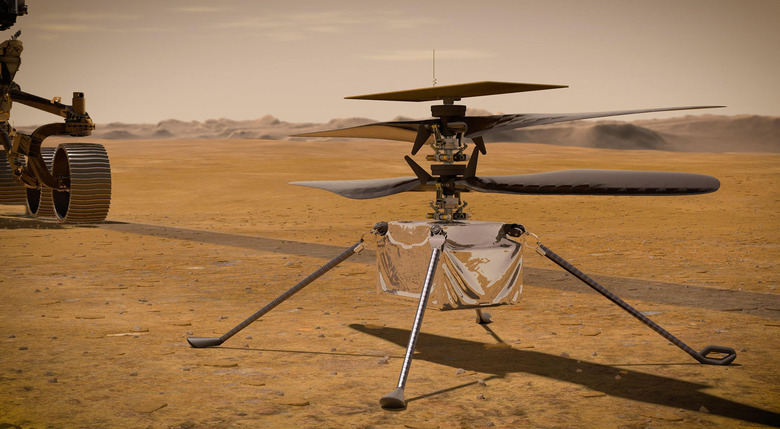Here's What NASA Wants Its Mars Helicopter To Do Next
NASA has already made history with its Mars rover Ingenuity. The chopper's first flight proved that powered aircraft are viable on Mars, while its second and third flights demonstrated that aerial drones could easily travel without crashing. Its fourth flight will be designed to show that a similar aircraft could potentially be used to map out regions of the surface and provide detailed observations over a wide area. These are more than enough to call Ingenuity a success, and NASA is already looking to the future.
In a new blog post on NASA's Jet Propulsion Laboratory site, the group explains that the Mars helicopter will be shifting into a new phase of its demonstration. The "operations" phase of the demonstration will hopefully show that Ingenuity and other aircraft built using the same technology could be used to boost the speed at which new discoveries are made on Mars. The idea is to use Ingenuity in a way that future missions might use dedicated aerial science aircraft, and it's pretty exciting stuff.
"The Ingenuity technology demonstration has been a resounding success," NASA's Thomas Zurbuchen said in a statement. "Since Ingenuity remains in excellent health, we plan to use it to benefit future aerial platforms while prioritizing and moving forward with the Perseverance rover team's near-term science goals."
The operations demonstration will require the helicopter to perform some of its most daring feats yet. There's no guarantee that the chopper will survive, but if it does it will be a huge step toward a future where powered flight is incorporated into future Mars missions.
NASA offers a brief summary:
Ingenuity's transition from conducting a technology demonstration to an operations demonstration brings with it a new flight envelope. Along with those one-way flights, there will be more precision maneuvering, greater use of its aerial-observation capabilities, and more risk overall. The change also means Ingenuity will require less support from the Perseverance rover team, which is looking ahead for targets to take rock and sediment samples in search of ancient microscopic life.
The helicopter has yet to conduct a one-way flight. Each of its flights began and ended in the same spot on the so-called "Wright Brothers Field," which is a flat area on the surface near where the rover and helicopter touched down. One-way fights would be similar to what a dedicated aerial science drone would perform as it travels large distances across the surface of the Red Planet.
Meanwhile, the Perseverance rover has been in a bit of a holding pattern. It has been conducting science as it hangs out in the area of the flight tests but has been required to remain in the general vicinity of the chopper so it can capture video of Ingenuity in action.
